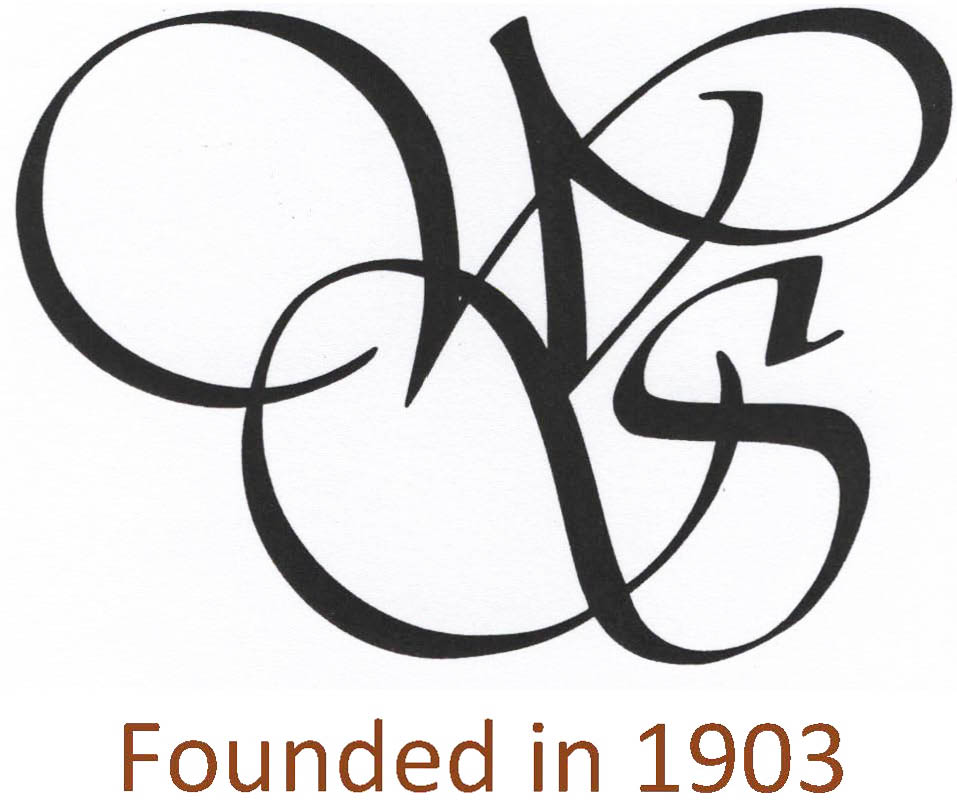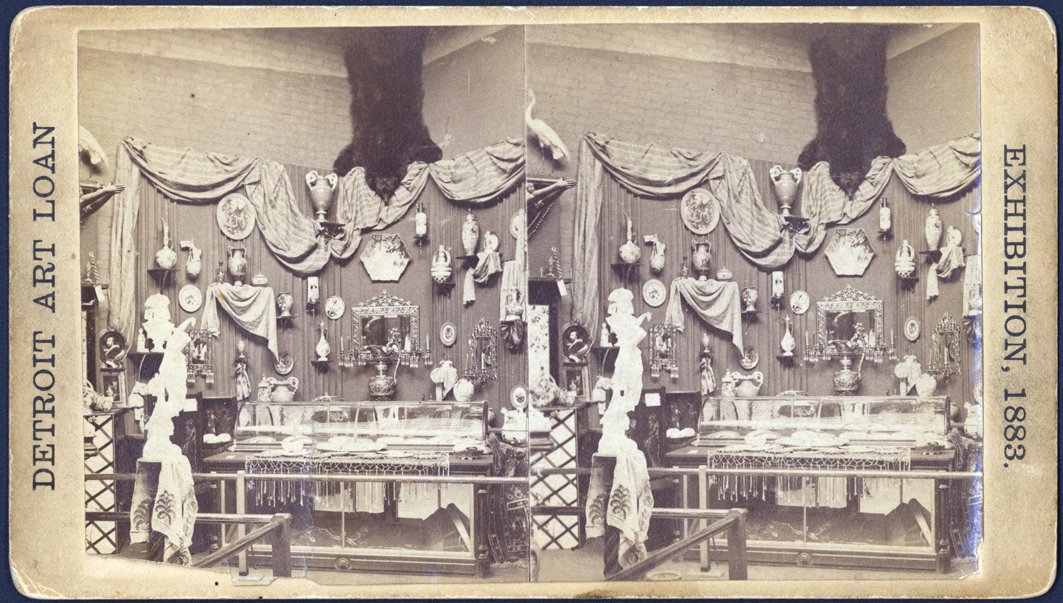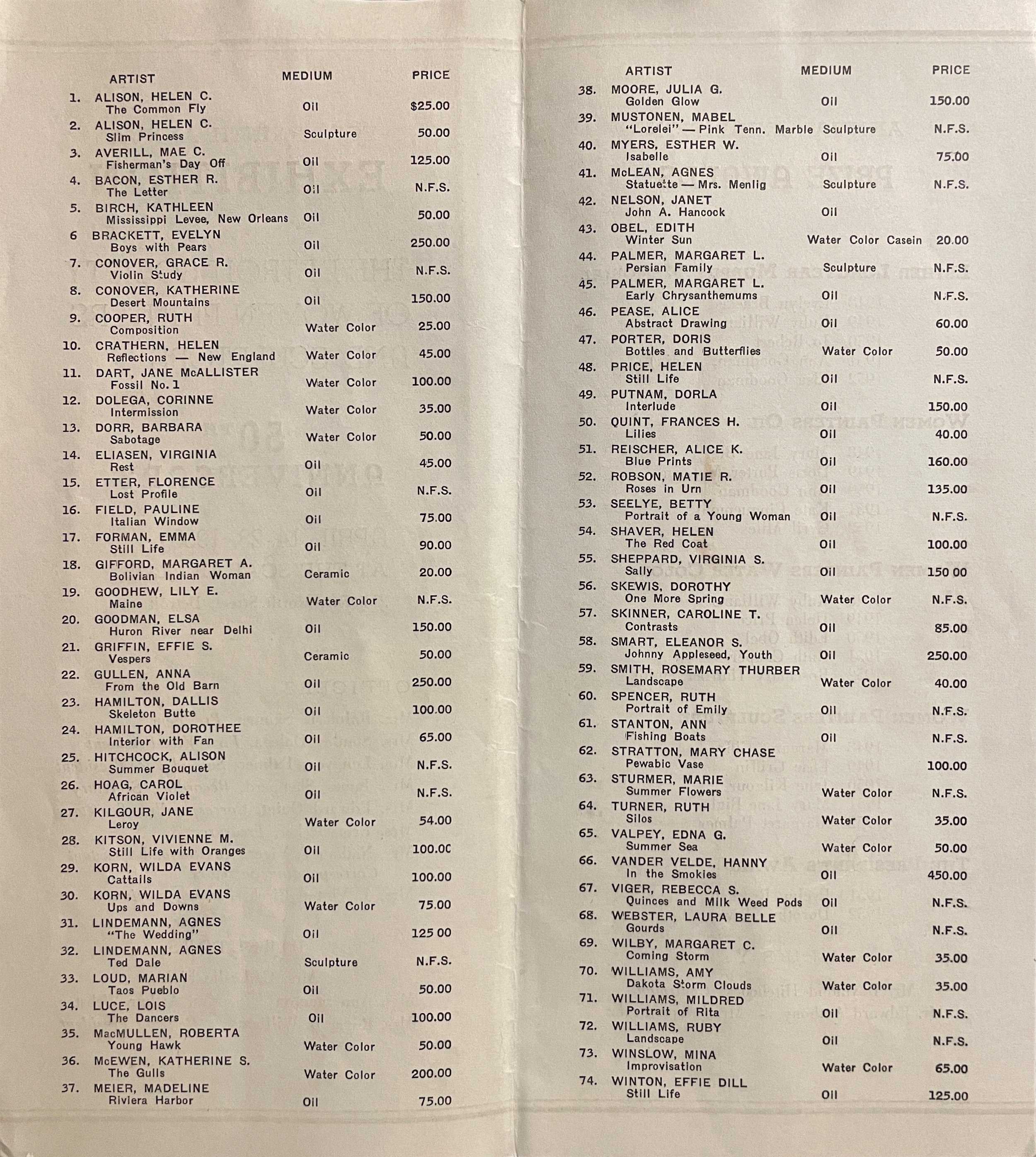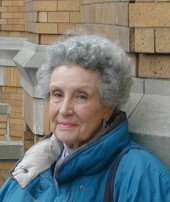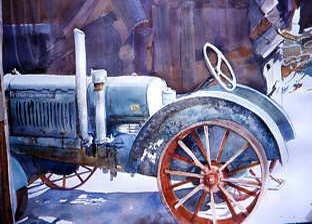Paintings and sculptures by members (and some portraits) from 1903 through the Twentieth Century can be found here.
Works by current members are collected here.
Items in boldface are clickable.
The Detroit Society of Women Painters and Sculptors
founded 1903
Based on research conducted in 2016-2017 by Jackie Rybinski
Adapted for the web in 2023 by Kathleen McNamee
From the minutes of the DSWPS organizational meeting Febraury 23, 1903
The Record of our Founding
“Detroit February 23rd, 1903: A meeting of the Women Artists of the city was called on Monday Evening Feb. 23, 1903 at Mrs. S. B. Meeser’s residence 46 Woodward Avenue Terrace to consider the advisability of organizing a Women’s Art Club. There were 16 artists present. After some discussion it was decided to organize an Art Club.
At the monthly meetings each member should bring in a piece of original work for comparison and criticism if the member so desire. It was also suggested that each member bring in some clipping from newspapers or magazines that would be of interest to the club. The plan was discussed and met with general approval.” (signed) Mariam L. Candler, Secretary
Woodward Ave, Detroit in the early Twentieth Century (note Hudson’s Building, opened in 1911, in the distance)
The Prime Mover: Lillian Meeser, who had studied at the Pennsylvania Academy of Fine Arts, first proposed establishing a women’s art society to stimulate and at the same time promote recognition of the work of women artists in Detroit. This was the genesis of the Detroit Society of Women Painters, the oldest organized art group in Michigan. (source; Julia Gatlin Moore, History of the Detroit Society of Women Painters and Sculptors 1903-1953 (1953), a volume published at the 50th anniversary of the Society.)
DSWPS members generally participated in all things related to art in Detroit and were frequently represented in the Annual Exhibit for Michigan Artists (now the Michigan Annual), which originally was hosted by the Scarab Club. Many members have exhibited in the best-known galleries in the country; in Europe, DSWPS members were invited to hang their pictures in galleries in Munich, Vienna, Venice, Rotterdam, and Warsaw.
Detroit and Art at the Turn of the Century
The first decades of the 20th century were a period of great change in Detroit. At the time of the Society’s founding, the population of the city was growing rapidly because of the city’s prominence both as an industrial center (it was the “Stove Capital of the World” and as a transportation hub between the Great Lakes and the Erie Canal).
The members of the new Society contributed both collectively and individually to the establishment of Detroit’s major art institutions. During the more than 120 years since then, most Detroit women who have seriously engaged in painting have belonged to the group. In 1930, it changed its name to include sculptors as well as painters.
An early Twentieth-Century European figure-drawing class
Make no mistake. In 1903, men dominated in the field of art. Well into the 19th century women were excluded from art academies. Toward the end of the century, restrictions gradually relaxed, particularly in the United States, England, and France. (Life-drawing classes remained segregated by gender, however.) In Germany women were not admitted to the academies in Berlin, Munich, and Dusseldorf until after the 1910s and 1920s.
Students at the Pennsylvania Academy of Fine Arts, a leader in admitting women and the place where some DSWPS founders studied
The DSWPS, the Art Loan Exhibition and the Effort to Create a Permanent Art Collection for Detroit
Even before the creation of the DSWPS, women who would number among its founding members took part in institutionalizing the arts in Detroit. The first suggestion of an art museum for Detroit came in 1882 from William Brearley, reporter for the Evening News. He formed a women’s committee to arrange a Loan Exhibition that he hoped would arouse local interest in a permanent collection for the city. The several committees set up at the organizing meeting all consisted of women…except the finance committee.
Temporary brick building built to house the Art Loan Exhibition for 10 weeks in 1883. Note the sculpture (?) in the lower right corner: post with key, straight razor, and other items on curved arms. Written over entrance: "Art Loan Exhibition." Source: https://digitalcollections.detroitpubliclibrary.org/islandora/object/islandora%3A148360
To make the project a reality Mrs. Lucy Crapo-Smith, who would become the prime mover in the establishment of DSWPS, spent three months in Europe at her own expense collecting works of art from European artists. Mrs. Storrs Willis (widow of Barnabas Campau, scion of one of the first French families to settle in Detroit in the early Eighteenth Century ) gathered treasures in this country on loan or on commission.
Ceramics and …bear skins. Source: https://digitalcollections.
detroitpubliclibrary.org/islandora/object/islandora%3A161391
In September 1883, the Art Loan Exhibition opened its doors in a building on Larned near Bates, just east of Woodward. The exhibition was a smashing success. It included nearly 5,000 works of art and represented several schools and led, as the organizers hoped, to the creation of a permanent art museum in Detroit. Detroiters poured in to view the exhibit, sometimes at a rate of two thousand a day. Note the artefact in the lower right corner: a post with key, straight razor, and other items on curved arms. "Art Loan Exhibition" is written over entrance to the building.
1904: DSWPS and The Detroit Museum of Art
Detroit’s interest in art had been aroused, and plans immediately began to raise money to build and endow a permanent city art museum. In 1888, the Detroit Museum of Art became a reality, housed on the corner of Jefferson and Hastings. (Source: Alice Tarbell Crathern, In Detroit Courage was the Fashion: The Contribution of Women to the Development of Detroit from 1701 to 1951 [1953])
Detroit Museum of Art building, southwest corner of East Jefferson Ave and Hastings; closed in 1927 (collections moved to the new Detroit Institute of Arts); demolished in 1960 to make way for Interstate 375
The first annual exhibition of the Detroit Society of Women Painters and Sculptors was held at the Detroit Museum of Art in 1904, and DSWPS exhibitions continued annually a quarter century.
They were well received:
“Up until a year ago, such a thing as a society of women artists was unknown in Detroit. Indeed, it was not thought possible that such a thing could exist, as it was believed there were too few women painters to keep up an organization.” (Detroit Free Press, reviewing the 1904 exhibition)
“Their annual appearances are becoming events to be anticipated long before they take place.” (A Detroit newspaper reporting on the DSWPS exhibition of 1905)
To this day the Society, as a group, has continued to exhibit at least once a year in art venues in the Detroit area.
1905: A Room of Their Own
“The Detroit Society of Women Painters, organized two years ago as a working club for Detroit Women artists, is to have a new home. Mrs. Charles Lothrop, the first vice president of the club, has fitted up a studio at 121 Fort Street West and here the club will meet three times a week to paint. A skylight has been put in and models will be furnished. Later it is hoped to secure some artist as critic and instructor, but at present the members will work alone. The club was organized through the efforts of Mrs. Spencer B. Meeser, its president, and has so far met in her home. In order to join the artist must first submit some of her work to the club, and if it is thought that she will be able to keep up with the club she is admitted on payment of her fee. At each meeting the members are expected to bring some new work. The picture is put up before the club with no name attached, and everyone present is free to criticize, either commending or offering suggestions.” (a Detroit newspaper)
DSWPS Engagement with Art Organizations in Detroit
1906: The Detroit Society of Arts and Crafts
Frances Sibley (seated), a founding member of the Society of Arts and Crafts, with great-nieces Katherine McEwan (left) and Alexandrine McEwan (right), both founding members of DSWPS, 1906 (the man is unidentified)
From the start, founding members of DSWPS were involved in institutionalizing the arts in Detroit. The Detroit Society for Arts and Crafts, organized in 1906 was inspired by the English Arts and Crafts movement, began with a small group of artists, many of them DSWPS founding members. These included Katherine McEwen, her sister Alexandrine McEwen (whose studio on Jefferson was one of the homes of the Women Painters), Mary Chase Perry, her future husband William Stratton, her ceramics partner James Calkins, and the philanthropist George Booth (founder of the Cranbrook Educational Community, co-founder of the predecessor of The Detroit News, and owner of Scripps-Booth autos, later bought by General Motors).
1911: The Detroit School of Design and the DSWPS
William B. Stratton (husband of Mary Chase Perry Stratton) approached the Society for support in funding the Detroit School of Design. Artists contributed individually, and the Society voted as a group to donate half the DSWPS treasury to get the project off the ground. The School, which opened in 1911 at Jefferson and Rivard, produced many outstanding automotive designers, including the father of current DSWPS member Charmaine Kaptur. Marion Loud (1880-1956), president of DSWPS from 1929 to 1931, served as dean of the Detroit School of Design and later headed the Department of Art at University Liggett School for 25 years.
DSWPS and the Great War
During World War I, a DSWPS member living in France wrote asking for money to feed starving families of the artists in Paris. Each contribution of ten cents to the “Paris Canteen,” she said, would buy two meals for those devastated by the war. The Society responded and received in return a “Thank You Poster” signed by 44 French artists and decorated with their sketches.
DSWPS Between the Wars: Showing and Growing
[Wilhelm Valentiner served from 1924 to 1945 as Advisor and then Director of the Detroit Institute of Arts; Clyde Burroughs preceded him in that role from 1917 to 1924, having held directorial posts at the DIA’s predecessor, the Detroit Museum of Art; Katherine McEwen (1875 - 1954) co-founder in 1906 of the Detroit Society of Arts and Crafts, which became the College for Creative Studies in 2001.]
1926: The Society maintained cordial relations with luminaries in the art scene in Detroit, as the guests attending a 1926 meeting demonstrate: “The Regular Monthly Meeting of Jan. 4th was held at Mrs. Theodore A. McGraw’s studio, Lincoln Road, Grosse Pointe. No pictures were shown. The time was given to listening to a most instructive and interesting talk by Mr. Walter Pack, art writer and lecturer, on the cause and reason for the “New Art Movement,” with characteristic comparisons and descriptions of many well-known painters. …After the meeting Mrs. Theodore A. McGraw entertained the Society and invited guests. Mrs. L. C. Stanley and Miss Eleanor Candler presided at the table, among the guests were Dr. Valentiner, Mr. and Mrs. Clyde H. Burroughs, Mr. and Mrs. Stratton and Miss Katharine McEwen, Honorary President.”—Della Garretson, Recording Secretary (from the minutes of January 4, 1926)
1927, The Detroit Institute of Arts: The system of annual DSWPS exhibitions at the Detroit Museum of Art changed in 1927, when the Museum became the Detroit Institute of Art and moved to Woodward Ave. DSWPS continued to contribute to the DIA’s Museum Picture Fund (later renamed the Founders Society) and, for many years, to hold meetings in its Founders Lounge. After the Detroit Institute of Arts and the Detroit Society of Women Painters and Sculptors parted ways, the Scarab Club began in 1933 to host the annual exhibition of the DSWPS. The partnership lasted forty years (women, however, could not join the Scarab Club until 1962).
1928: Beginning in 1928 DSWPS exhibited every year in the Fine Arts Gallery of the J.L. Hudson Company, which concentrated on Twentieth-Century art.
So widespread was the reputation of the Society of Women Painters that they were asked to exhibit at the Holt Gallery in New York City in 1928 in an exhibit financed by a group of women who were not painters themselves, but who for several years contributed to the Society as sustaining members. In 1932 a second exhibit was offered in New York, with 29 women artists hanging their work.
DSWPS members at an exhibition of their work at the Holt Gallery, New York City, November 4, 1928. From left, Rose Mary Thurber, Mildred Emerson Williams, Lillian Garretson and her twin Della Garretson, Esther McGraw, Mrs E. Bradfield
Almost sixty years later, Frances H. Quint (1921-2022), DSWPS Historian, offered trenchant commentary about the effect this show had on her—both when she saw it in 1928 and subsequently:
May 15, 1986
“On a pleasant autumn Saturday in 1928, I wandered into an art gallery in New York and there, to my surprise, I ran into an exhibition of paintings by the members of the Detroit Society of Women Painters. I remember feeling a sense of pride in the fact that there existed a group from my home town with enough merit and spirit to exhibit in that holiest of holy places, New York City. However, as an art student at the time, I had undergone some brainwashing. I had become acquainted with the works of John Marin and Georgia O’Keefe and other contemporary greats. These paintings from Detroit were not abstract. They were not expressionistic. They were, in no sense, shocking. They were not even modern, as the word was used at that time. How was I to know anything about good, sound painting? Then I began to wonder: why an organization of women painters, anyway? Art was Art, after all. What difference did it make whether the artist was male or female? It didn’t show.
I hasten to say that twelve years later, I had become a member of the real world. I was, in fact, pleased and flattered to be invited to join that very same group. I had come to understand that, although gender in art may be meaningless, there were certain definite and pleasant advantages to belonging to a women’s group.”
1932: The story goes that the Detroit Artists Market (DAM) was founded in a garden in Grosse Pointe during the Great Depression as a venue for artists to exhibit and sell their work. The founders were led by socialite and DSWPS member Mildred Simpson (or as she preferred to be known, Mrs. H. Lee Simpson). DSWPS members have participated in DAM open-call shows since its inception. The Garden Party Art Show and Sale was a well attended annual DAM event for decades.
1952 DAM Garden Party
1940: “The first monthly meeting of the Detroit Women Painters and Sculptors was held at Children’s Home on October 4 1940. Mrs. Hewitt is the guiding hand of an amazingly artistic group of children. (She) told us in detail of the environment, personality and inspiration of these extremely gifted children whose ages ranged from two to fourteen years.
1953: DSWPS celebrates its fiftieth anniversary with an exhibition at the Scarab Club.
Some Notable Members, from 1903 to the Twenty-First Century
Letta Crapo-Smith was the first Detroiter to have a painting hung at the Paris Salon. Other members whose works also were featured at the Salon are Anna Reig, Isabelle Lothrop (founding member, b. 1858, shown below in a portrait by her teacher, William Merritt Chase); Della Garretson (1859-1940), and Alice Guysi (1863–1940, founding member).
William M. Chase, Portrait of Miss (Isabella) L(othrop) 1913
At least four members have been honored by having their pictures in the permanent collection of the Detroit Institute of Arts: Letta Crapo-Smith (1862-1921), Della Garretson, Katherine McEwen (1875-1957), and Mildred Emerson Williams (1892-1967).
A fine American painter and lithographer, Mildred Emerson Williams first studied art at the Pennsylvania Academy of Fine Arts and at the Art Students League of New York, under Robert Henri, John Sloan, and George Luks.
Della Garretson’s portrait of her twin Lillie Garretson was exhibited at the Paris Salon 1902 and is now in the permanent collection of the DIA. Both twins were DSWPS members.
Matie Robinson (1872-1974), a Detroit Grandma Moses who lived to 102, sold four hundred pictures between her seventieth and her eightieth birthdays.
Mary Chase Stratton Perry, an original member of DSWPS, founded Detroit’s iconic Pewabic Pottery in 1903, the founding year of DSWPS.
Alice Hagerman (1871-1952) during her active painting years sold over 300 paintings. So impressed was a French art critic with one of her canvases exhibited in New York that he wrote her up in the Paris Review.
Betty Yorgen (1914-2019) served as president from 1984 to 1986 and had a one-woman show at National Art Museum of Sport 1992. “Her life has been her canvas.”
Gloria Goedeke In 1975 her work appeared on the cover of Michigan Academician, a publication of the Michigan Society of Arts and Letters. She was the owner of Renaissance Gallery in Harmony Park, Detroit and of the Goedeke Gallery in Petoskey, Michigan.
Helen Cartmell (d. 2015) A prolific oil painter and portrait artist, she showed in the Goedekke Gallery in Harmony Park to rave reviews in the Detroit News. She assisted in the murals in the People Mover stations, using dry pigments before the firing of the tiles. She received awards in most shows she entered. She won a Fellowship at Henry Clews Art Foundation in La Napoule (France) and later served as Educational Media Art Director at the Center for Instructional Technology at Wayne State University.
Lorraine McCarty (1920-2004), an aviator with All Women Transcontinental Air Races, served as official artist for the US Air Force. Her work is part of the collection of the Smithsonian National Air & Space Museum, and she is listed in Who’s Who of American Art. For more information on Lorraine McCarty’s life, click here.
Climb Out
Louise J. Nobili, Escape in the Night, 1983
Louise Nobili (1917-2004) A professor of art at Wayne State University from 1944-1983, her works reside in the permanent collection of the Detroit Institute of Art. For an oral history interview with Louise Nobili from the Smithsonian, click here.
Mary Jane Bigler, Appenine
Mary Jane Bigler (1909-1995) Also a professor (of Art and Art History) at Wayne State University, she was instrumental in founding Michigan Water Color Society.
From left: Nancy Prophit, Bette Prudden, Frances Quint, Chloe Boehm, Corinne Dolega, Virginia Sheppard, and Marcella Ricca, Detroit Free Press May 15, 1980)
Nancy Prophit (1934-1999) In the 1970s Nancy started a 6-member artists coop after the studio where she painted closed. There, and at another studio/gallery on Mack, she organized a Monday Evening “Life Study Workshop”. She loved learning new things and even studied gold leafing and icon painting.
Joan Brace founded the Orion Art Center, which offers an annual scholarship in her name. She served also as Director of the Scarab Club and was honored with a retrospective exhibit at the American Academy of Paris.
Carol LaChuisa In 2023, Carol La Chiusa was awarded a Lifetime Achievement Award by the Michigan Water Color Society. In the 1980s and 1990s, she hosted “Watercolor Workshop with Carol LaChiusa” on public television in Detroit (Channel 32). She served as president of DSWPS and she is included in Who’s Who of American Women and in the Encyclopedia of Living American Artists.
Bette Prudden began as a pastel portrait artist at the Michigan State Fair. She took the job on sheer gumption, never having made a pastel portrait in her life, and she came to be known widely for her sensitive portraits of children, adults, and pets, which have been said to surpass photography. Her portraits reside in homes throughout the United States and in Europe. She also served as DSWPS president.
Jackie Rybinski served as DSWPS president from 2016 to 2018, taught art in Detroit and area schools, and created this history of DSWPS. She was made an Honorary Member of DSWPS in 2019 for her work compiling a history in photos and artifacts for the Detroit Historical Museum Retrospective Exhibit “DSWPS Then and Now 1903- 2014.” (That’s 111 years!)
With the spirited leadership of Joya Rush-Keli as President, we powered through COVID-19 and started holding some of our meetings on the internet. Shown: a Zoom membership meeting of April 2021
